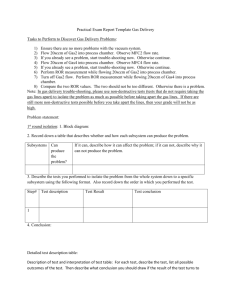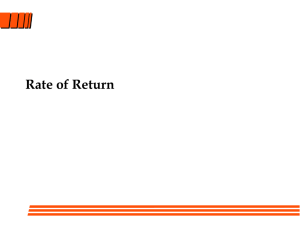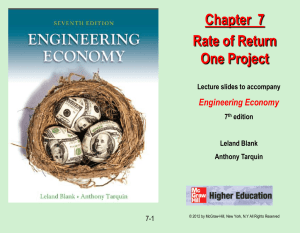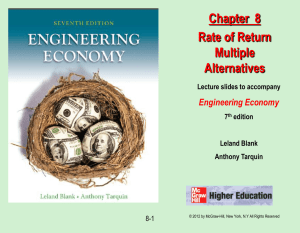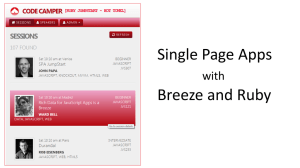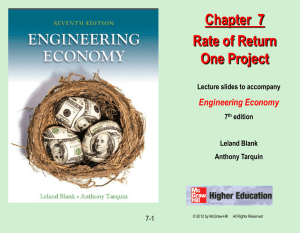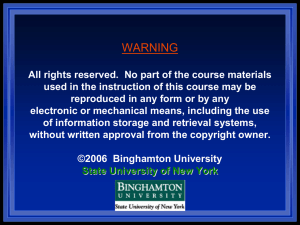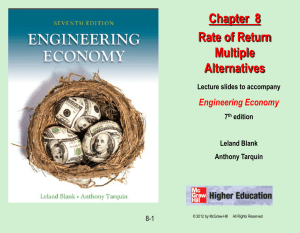Chapters 7 and 8 Rate of Return Analysis Incremental Rate of
advertisement
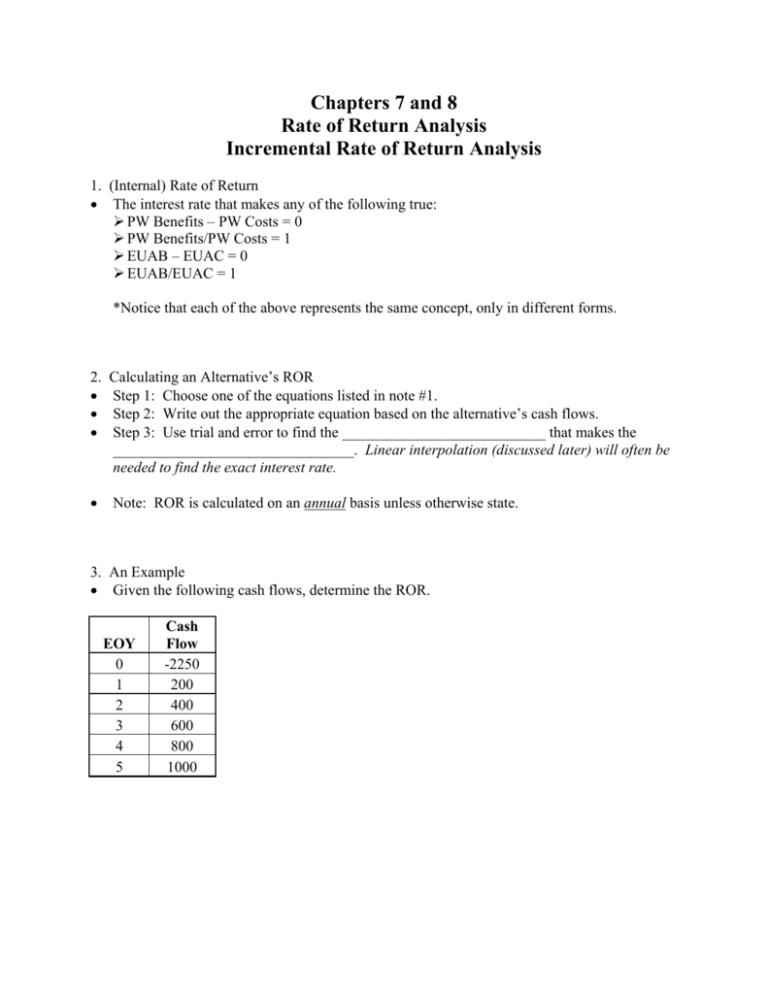
Chapters 7 and 8 Rate of Return Analysis Incremental Rate of Return Analysis 1. (Internal) Rate of Return • The interest rate that makes any of the following true: ¾ PW Benefits – PW Costs = 0 ¾ PW Benefits/PW Costs = 1 ¾ EUAB – EUAC = 0 ¾ EUAB/EUAC = 1 *Notice that each of the above represents the same concept, only in different forms. 2. • • • Calculating an Alternative’s ROR Step 1: Choose one of the equations listed in note #1. Step 2: Write out the appropriate equation based on the alternative’s cash flows. Step 3: Use trial and error to find the ___________________________ that makes the ________________________________. Linear interpolation (discussed later) will often be needed to find the exact interest rate. • Note: ROR is calculated on an annual basis unless otherwise state. 3. An Example • Given the following cash flows, determine the ROR. EOY 0 1 2 3 4 5 Cash Flow -2250 200 400 600 800 1000 • We know that the ROR is between ____% and ____%. Therefore, we need to use linear interpolation to find the exact rate. • While we could use formulas (for the factors) to find the exact rate of return, we will usually save time by interpolating between the two interest rates (from the back of the book) that give us the closest (to zero) positive NPW and closest (to zero) negative NPW. ***************Interpolation on NPW (or EUAB – EUAC) Values******************* ROR = ⎡ ⎛ ⎞⎤ NPW at lower % - 0 ⎟⎟⎥ lower % + ⎢(higher % - lower %) * ⎜⎜ NPW at lower % NPW at higher % ⎝ ⎠⎦ ⎣ Note: For EUAB – EUAC values, substitute EUAB – EUAC wherever NPW appears in the above equation. ****************************************************************************** Therefore, ROR = 4. Another Example • Find the ROR for the following alternative. EOY 0 1 2 3 4 Cash Flow -1000 0 250 500 750 • • In this situation, we only have one unknown factor (i.e., P/G, i%, 4). • In situations like this, it is easier to solve for the unknown factor and search for its value in the interest tables in the back of the book. • We know the ROR is between ____% and ____%. Therefore, we will use linear interpolation to find the exact ROR. • The linear interpolation is similar to that used earlier. ************************Interpolation on Factor Values (Note: This only works for situations with one unknown factor)********************************************* ROR = ⎡ ⎛ Factor Value at lower % - Factor Value at ROR % ⎞⎤ ⎟⎟⎥ lower % + ⎢(higher % - lower %) * ⎜⎜ Factor Value at lower % Factor Value at higher % ⎝ ⎠⎦ ⎣ **************************************************************************** Therefore, ROR = 5. Making a Decision: One Alternative • If the ROR > MARR, the alternative is acceptable. • If the ROR < MARR and do-nothing is an option, do-nothing should be chosen. • If the ROR < MARR and do-nothing is NOT an option, then the alternative is to be chosen because it is the only available alternative. 6. Incremental ROR (∆ROR) Analysis • Incremental ROR analysis must be used when choosing between ______________________. • Incremental ROR is the ROR that is found on the __________________________________ ______________________________. • The difference is calculated by subtracting the cash flows for the lower cost alternative from the cash flows for the higher cost alternative (i.e., high cost alternative – low cost alternative) • The high/low cost alternative is based on the higher/lower initial cost. If you were to have the EUAB and EUAC calculations for both alternatives, then use EUAC to determine the higher/lower cost alternative. 7. Making a Decision: Two Alternatives • If ∆ROR > MARR, choose the ___________________________. • If ∆ROR < MARR, choose the ___________________________. 8. Example • Use incremental ROR (∆ROR) Analysis to choose between the following two alternatives. • MARR = 9%. EOY 0 1 2 3 4 5 ROR Alt. A -17500 5000 5000 5000 5000 5000 13.20% Alt. B -21000 5000 5500 6000 6500 7000 12.40% • Note: Both options are acceptable based on the MARR. • Since Alt. B is the higher cost alternative, we will calculate the incremental cash flow based on _______________________ EOY 0 1 2 3 4 5 ROR Alt. A -17500 5000 5000 5000 5000 5000 13.20% Alt. B -21000 5000 5500 6000 6500 7000 12.40% 9. Another Example • Utilize ROR Analysis to decide which, if any, of the following alternatives should be accepted. • MARR = 10%. Alternative 1 $2,000 Initial Cost Annual Benefits $700 $100 Annual Costs $500 Salvage Value 5 Useful Life 2 $3,000 $1,100 $300 $750 5 • The first thing we need to do is to make sure we have at least one alternative with a ROR > MARR. • Alternative #1 • NPW = 0 = -2000 + 700(P/A, i%, 5) – 100(P/A, i%, 5) + 500(P/F, i%, 5) • At 15% • NPW = -2000 + 700(3.352) – 100(3.352) + 500(.4972) • NPW = +259.80 • At 18% • NPW = -2000 + 700(3.127) – 100(3.127) + 500(.4371) • NPW = +94.75 • At 20% • NPW = -2000 + 700(2.991) – 100(2.991) + 500(.3277) • NPW = -41.55 • We know that the ROR is between 18% and 20%. Therefore, we will use linear interpolation to find the exact ROR. ROR for Alternative #1 ROR = ⎡ ⎛ 94.75 - 0 ⎞⎤ 18% + ⎢20% - 18 %) * ⎜ ⎟⎥ ⎝ 94.75 - - 41.55 ⎠⎦ ⎣ = 18% + 2%(.695) = 19.39% • Because we know that at least one of the alternatives is acceptable, the do-nothing option is eliminated, and we can move on to Incremental Analysis. Remember to use high cost – low cost. 10. Another Example • Given the following two alternatives and Rate of Return Analysis, determine which, if any, should be chosen. • MARR = 15% Alternative Initial Cost Annual Benefits Annual Costs Salvage Value Useful Life Classic $20,000 $7,000 $1,000 $2,000 5 Platinum $33,000 $8,500 $1,500 $2,500 10 • The first thing we need to do is to make sure that at least one alternative has a ROR > MARR. • • Alternative: Classic NPW = -20000 + 6000(P/A, i%, 5) + 2000(P/F, i%, 5) • Because we know that at least one of the alternatives is acceptable, the do-nothing option is eliminated, and we can move on to Incremental Analysis. Remember to use high cost – low cost. EOY 0 1 2 3 4 5 6 7 8 9 10 Classic Platinum -33000 7000 7000 7000 7000 7000 7000 7000 7000 7000 9500
